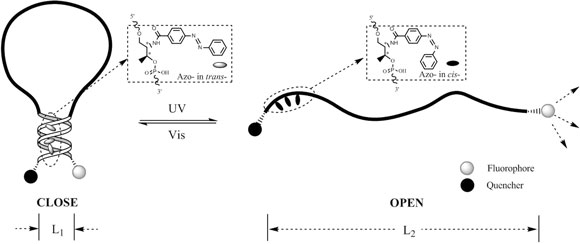| Posted: Jun 10, 2009 | |
Photon-fueled single-molecule DNA nanomotor |
|
| (Nanowerk Spotlight) Molecular-size motors have evolved in nature, where they are used in virtually every important biological process. In contrast, the development of synthetic nanomotors that mimic the function of these amazing natural systems and that could be used in man-made nanodevices is in its infancy. Building nanoscale motors is not just an exercise in scaling down the design of a macroworld engine to nanoscale dimensions. Many factors such as friction, heat dissipation and many other mechanical behaviors are just very different at this scale – everything is constantly moving (under kinetic energy supplied by the heat of the surroundings) and being buffeted by other atoms and molecules (Brownian motion). | |
| In addition to organic molecules, scientists increasingly are looking to DNA as a very promising way to fabricate nanomotors (see for instance "Synthetic DNA nanomachines go to work inside living cells " or "Nanorobotic arm to operate within DNA sequence"). The concept of a single DNA molecule nanomotor was already introduced in early 2002 (A Single DNA Molecule Nanomotor). | |
| However, this and subsequent designs require addition and removal of fuel and waste strands for motor function, although some artificial nanomotors can utilize alternative energy sources, including hydrolysis of the DNA backbone and ATP. Researchers at the University of Florida have now designed a photoswitchable single-molecule DNA nanomotor. It is the first fully reversible single-molecule DNA nanomachine driven by photons without any additional DNA strands as fuel. | |
| In another novelty, this novel nanomotor uses a hairpin structure whereas most existing DNA nanomachine designs are based on linear DNA hybridization. There are a few using hairpin DNA as fuel, but none of them is using this structure as the main backbone. | |
 |
|
| The structural change of DNA displayed a contraction (CLOSE) state when tethered azobenzene moiety (Azo-) takes trans conformation under visible light irradiation and an extension (OPEN) state when Azo- takes cis conformation under UV light irradiation. The L1 is the average size of hairpin structure based on the distance between F/Q pair, and L2 is the average size of extended molecules based on persistence length of a single DNA strand. (Reprinted with permission from American Chemical Society) | |
| "By focusing on photonic energy driving movement, our research explores the feasibility of regulating the dehybridization (open state) and hybridization (close state) of a hairpin structure by controlling the photoresponsive azobenzene moieties integrated on the DNA bases in the hairpin’s duplex stem segment," Huaizhi Kang explains to Nanowerk. "Because of its reversible extension-contraction behavior, the open-close cycle of the hairpin molecule is considered a molecular motor, and such motion can be characterized by monitoring fluorescence variation between a fluorophore and a quencher on both ends of the stem." | |
| Kang, a doctoral student in chemistry at the University of Florida is the first author of a recent paper in Nano Letters (Single-DNA Molecule Nanomotor Regulated by Photons) and member of Weihong Tan's research group, who reported these findings. | |
| In its clasped, or closed, form, the nanomotor measures 2 to 5 nanometers. In its unclasped form, it extends as long as 10 to 12 nanometers. Although the scientists say their calculations show it uses considerably more of the energy in light than traditional solar cells, the amount of force it exerts is proportional to its small size. | |
| To make the nanomotor, the researchers combined a DNA molecule they created in the lab with azobenzene, a chemical compound that responds to light. A high-energy photon prompts one response; lower energy another. | |
| To demonstrate the movement, the researchers attached a fluorophore, or light-emitter, to one end of the nanomotor and a quencher, which can quench the emitting light, to the other end. Their instruments recorded emitted light intensity that corresponded to the motor movement. | |
| While potential applications could range from solar cells based on DNA molecules to giant DNA structures that can collect molecular forces from each DNA motor, the major challenge ahead for the researchers is the task of designing a device that collects the molecular level force into a coherent accumulated force that can do real work when the motor absorbs sunlight. The team is also continuing its investigation of the relationship between hairpin structure and energy conversion efficiency in order to fully understand the mechanisms underlying the energy conversion process. | |
| "Nevertheless" says Kang, "this clean, photon-fueled nanomotor holds promise for applications that require the conversion of photonic energy into other forms of energy, such as mechanical movement. In addition, photo-regulated DNA nanomotors can be easily manipulated and reproduced, as our design is simple and easy in terms of synthesis and operational strategy." | |
 By
Michael
Berger
– Michael is author of three books by the Royal Society of Chemistry:
Nano-Society: Pushing the Boundaries of Technology,
Nanotechnology: The Future is Tiny, and
Nanoengineering: The Skills and Tools Making Technology Invisible
Copyright ©
Nanowerk LLC
By
Michael
Berger
– Michael is author of three books by the Royal Society of Chemistry:
Nano-Society: Pushing the Boundaries of Technology,
Nanotechnology: The Future is Tiny, and
Nanoengineering: The Skills and Tools Making Technology Invisible
Copyright ©
Nanowerk LLC
|
|
|
Become a Spotlight guest author! Join our large and growing group of guest contributors. Have you just published a scientific paper or have other exciting developments to share with the nanotechnology community? Here is how to publish on nanowerk.com. |
|
